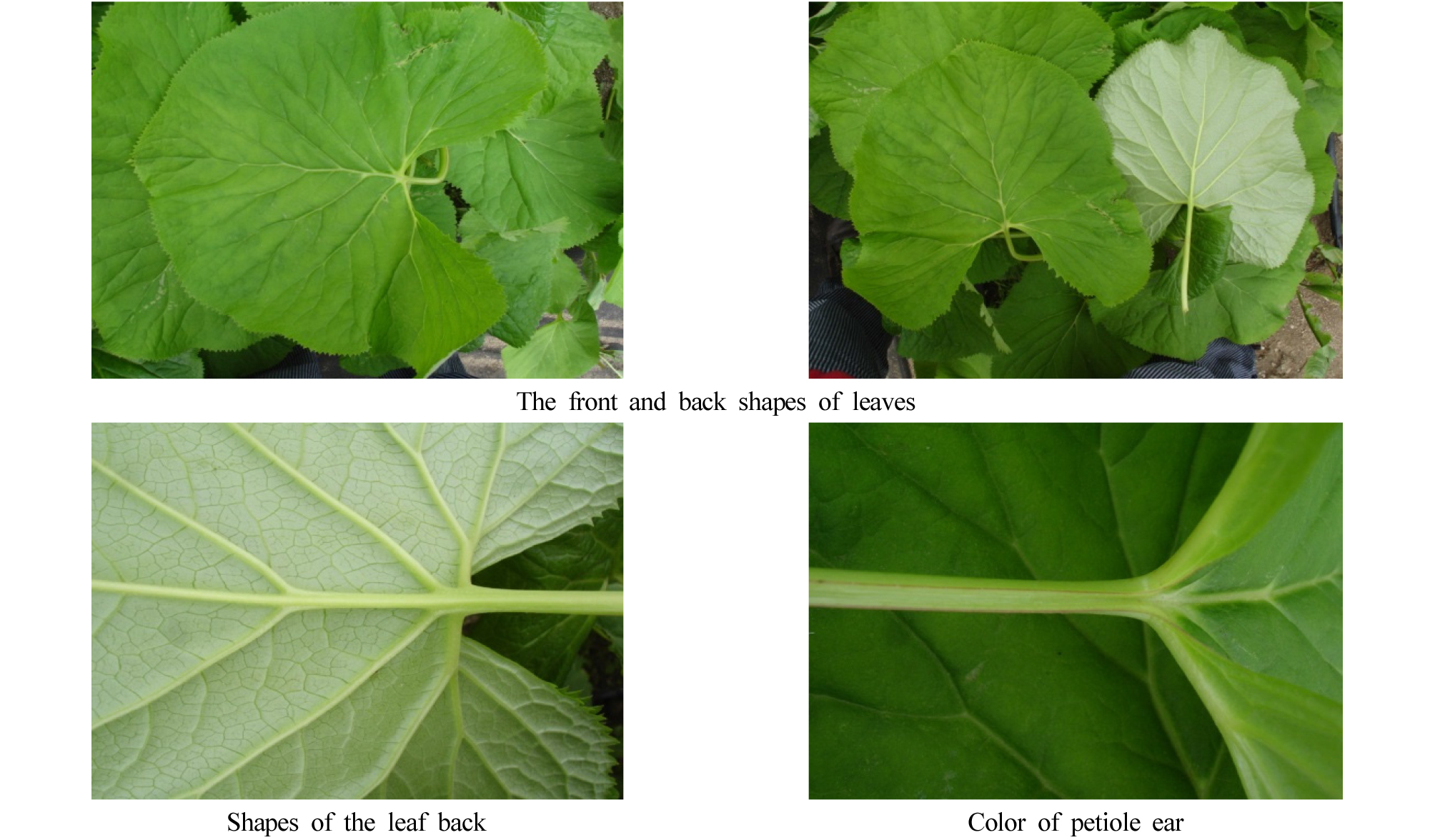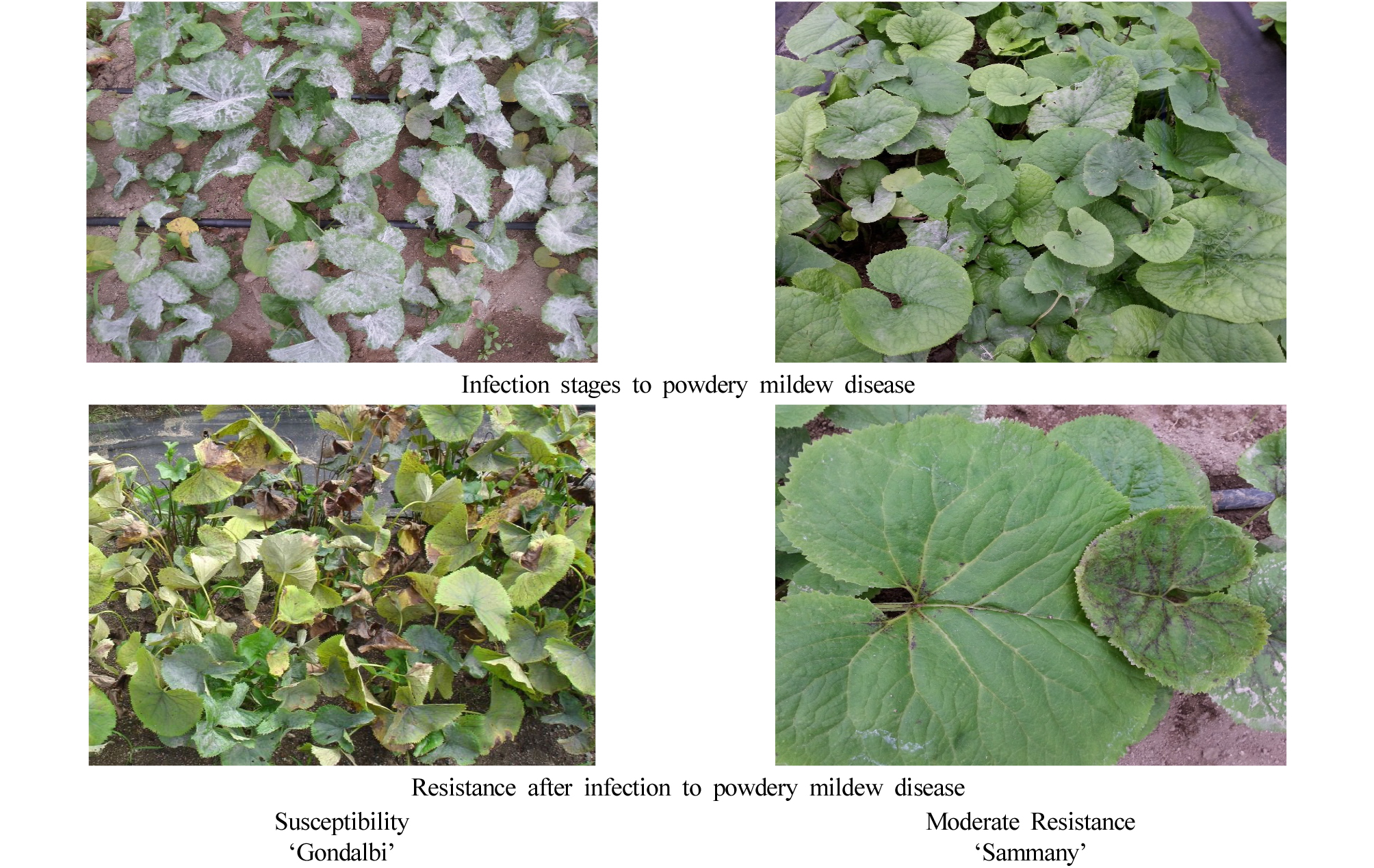Introduction
Gomchwi is a perennial plant grown nationwide within Korea. Gomchwi leaves can be consumed as fresh leaves or boiled. Dried form of leaves can be stored for later use. Because of antioxidant content, Gomchiw has been recognized as a good nutrition source providing vitamins and minerals in various forms (Cho and Kim, 2005). Dried roots have been used to cure asthma, back pain, joint pain, and bruises in oriental medicines and pharmaceutical ingredients to cure jaundice, high blood pressure, and a liver disease were extracted from Gomchwi (Lee, 2006). In particular, it has been reported that the activity of Gomchwi extract has been proven and contains a large amount of antioxidants (Kim et al., 2010). In addition, application to skin care such as skin whitening, anti-inflammation, melanin biosynthesis, freckle and age spot have been introduced and broader application to control platelet coagulation and cancer cell treatment has been accessed (Ham et al., 1998; Bae et al., 2009; Yeon et al., 2012). Recently, Suh et al. (2015) investigated antioxidant levels in newly developed varieties, ‘Sammany’, ‘Gommany’ and ‘Damogy’ harvested between May and July in highland and found that all new varieties had accumulated higher antioxidant level from early June.
Susceptible to powdery mildew in summer can significantly lower yield and product quality, and continued cultivation at the same location can accelerate yield loss. Genetic solution to control powdery mildew through new resistant cultivar breeding is preferred to chemical approaches due to consumer acceptance and food safety reasons. Therefore, Gomchwi susceptible to powdery mildew disease was crossed to ‘Handaeri- gomchwi’ with resistant to powdery mildew and growing more vigorously, and ‘Gommany’ and ‘Damogy’ were developed as a result (Suh et al., 2016; Suh et al., 2017).
Growth and flowering trait characterization for ‘Sammany’ variety was conducted by the manual for agricultural investigation (RDA, 1995) and phenotyping guidelines for new varieties by Ligularia fischeri (Bae et al., 2008).
Materials and Methods
The ‘Sammany’ variety was developed by a cross between a common ‘Gomchwi (Ligularia fischeri (Ledeb.) Turcz.)’ and ‘Handeari-gomchwi (Ligularia fischeri var. spiciformis Nakai)’ which is a variety with strong growth and powdery mildew disease resistance. Crossing was conducted in green house at Highland Agricultural Research Institute between July and September 2005. F1s found to be resistant to powdery mildew were planted in March 2006 and their growth habits were evaluated from May to August 2007. Growth and yield characteristics were investigated again in 2008 and a progeny, #615, showing acceptable yield and agronomic traits superior to commonly cultivated ‘Gondalbi (Ligularia stenocephala (Maxim.) Matsum. & Koidz.)’ was selected. Progeny, #615 was propagated in the open field from 2008 to 2009 and growth characteristics were monitored until 2011 (Fig. 1). The resistance of powdery mildew disease was determined by visual evaluation by comparing to 'Gondalbi' species. The 'Sammany’ variety with high yield and moderate resistant resistance to powdery mildew was selected as a candidate to advance as a new variety (Table 3, 4, Fig. 3).
‘Sammany’ was first registered as a new variety at the Forest Classification Management Center of the Forest Service. Based on field testing data collected between 2013 and 2016, it was finally registered with new variety name, ‘Sammany’ on May 11, 2017 (variety protection no. 131) and distributed to producers as ‘Sammany’.
Because ‘Sammany’ grows vigorously, frequent fertilization is recommended. Due to its perennial nature, it is recommended to spray enough compost and basal fertilizer every year. It is also recommended to use less amount of chemical fertilizers. The maximum temperature in the hot season in July and August in Highland was 27℃, and the average temperature was 20℃ (Fig. 4). This is the ideal temperature for growing ‘Sammany’. In summer, it should be covered with 50 % shading net to cool down the temperature if day time temperature increase beyond 27℃. Cultivating in a cool area above semi-highland is recommended for proper growth.
Results and Discussion
Table 1 summarized the leaf characteristics of ‘Sammany’. Petiole ear color of ‘Sammany’ was purple while it was pale green in ‘Gondalbi’. Both varieties have no petiole trichomes on both sides of leaves. There was luster on the back of the leaf on both varieties. Compared to ‘Gondalbi’ with third grade vein density, ‘Sammany’ variety has second grade vein class (Fig. 2).
Table 1. Comparison of leaf characteristics between ‘Gondalbi’ and ‘Sammany’ cultivars
| Cultivar | Petiole ear color | Petiole trichome | Trichome of leaf back | Leaf vein density |
| Sammany | Purple | Nonexistent | Nonexistent | 2z |
| Gondalbi | White green | Nonexistent | Nonexistent | 3 |
‘Sammany’ variety leaves were softer than ‘Gommany’ variety same as the report by Suh et al. (2016). Average growth characteristics are summarized in Table 2. Plant height was 46.2 ㎝, leaf length was 19.1 ㎝, leaf width was 19.5 ㎝ and petiole length was 32.1 ㎝ in the first year. Similar results were observed in the second year. ‘Sammany’ had the least plant height in the third year. However leaf length, width and petiole length in the third year were generally stable and uniform. The flowering and yields characteristics of the two varieties were summarized in Table 3. The bolting date was slightly different from year to year. ‘Gondalbi’ bolted in the middle of July while ‘Sammany’ bolted in August.
Table 2. Comparison of average growth characteristics between ‘Sammany’ and ‘Gondalbi’ cultivars for 3 years
Table 3. Comparison of flowering and yield characteristics between ‘Sammany’ and ‘Gondalbi’ cultivars for 3 years
Regarding flowering date, ‘Gondalbi’ started flowering in early to mid. August and ‘Sammany’ started in late August until early September. In the third year, ‘Sammany’ flowered on September 10 which is about 26 days behind ‘Gondalbi ’. Number of leaves of ‘Sammany’ increased after years and it was 156 per plant in the 3rd year while ‘Gondalbi’ had 130 per plant. The highest yield per plant of ‘Sammany’ was 1,385 g in the second year and then dropped to 1,077 g in the third year. However, the average yield during three growing seasons was still 74 percent higher than the ‘Gondalbi ’. This result was similar to the report by Suh et al. (2016, 2017).
The thickness of the leaves of ‘Sammany’ variety was 0.61 ㎜ while it was 0.46 ㎜ in ‘Gondalbi’. The hardness of the leaves of ‘Sammany’ variety was 20.8 kg/cm2. The hardness of the leaves in ‘Sammany’ was found to be lower than that of ‘Gondalbi (23.0 kg/cm2)’. The quality of ‘Sammany’ variety was reportedly better than ‘Gommany’ and ‘Damogy’, (Suh et al., 2016, 2017), because ‘Sammany’ has lower hardness but leaves are slightly thicker.
‘Gondalbi’ is a susceptible to powdery mildew diseases, while ‘Sammany’ variety was moderately resistant by visual evaluation (Table 4). Powdery mildew diseases was less in ‘Sammany’ than in ‘Gondalbi’ as shown in Fig. 3, Therefore ‘Sammany’ variety was more resistant than ‘Gondalbi’ (Fig. 3). The report by Suh et al. (2016, 2017) reported that ‘Gommany’ and ‘Damogy’ varieties were resistant to powdery mildew. As a result, ‘Sammany’ variety appeared to moderately resistant to powdery mildew diseases, high yield and quality.
Table 4. Comparison of average leaf characteristics and resistance to powdery mildew between. ‘Sammany’ and ‘Gondalbi’ cultivars
| Cultivars |
Leaf hardness (㎏/㎠) |
Leaf thickness (㎜) |
Powdery mildew resistancex |
| Sammany | 20.8 | 0.62 | MRw |
| Gondalbi | 23.0 | 0.46 | S |
| LSD .05 | N.S. | 0.15 |
wR (Resistance), MR (Moderate Resistance), S (Susceptibility).








